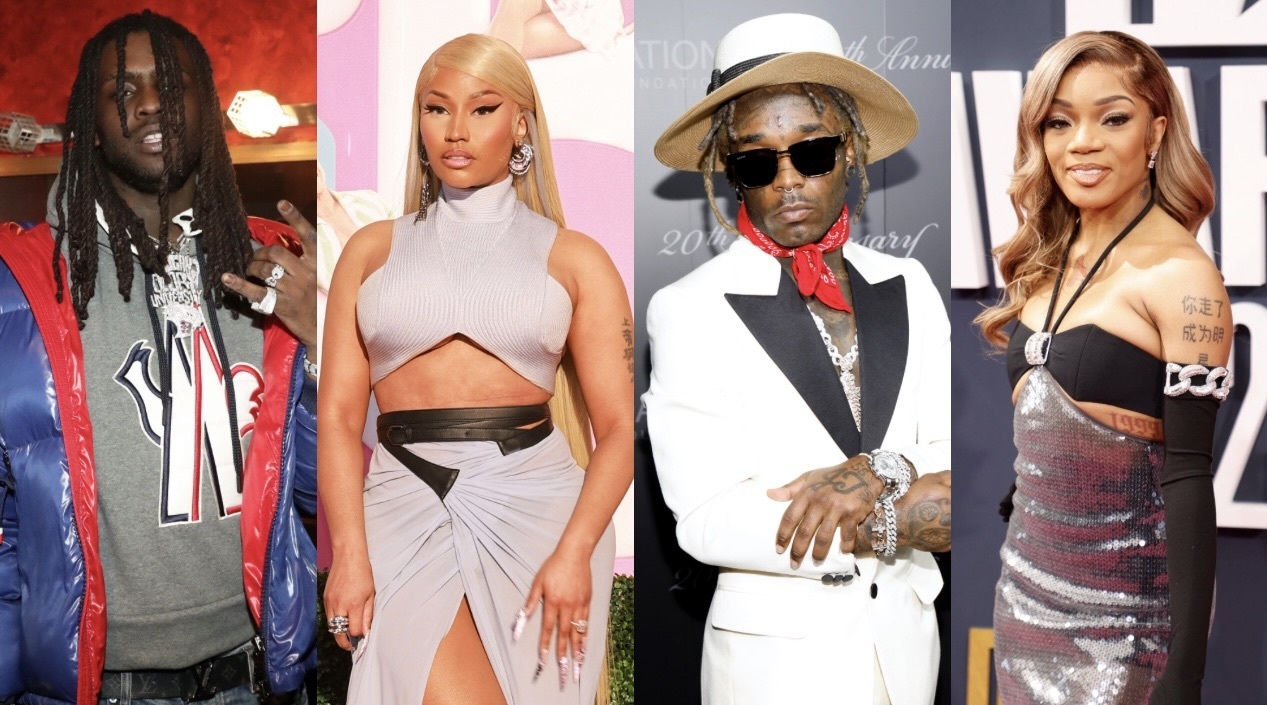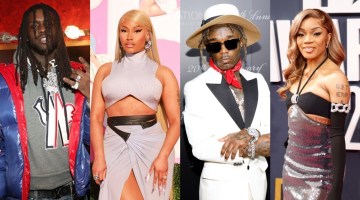50 Years Of Fiyah: A Look At Hip Hop From The 2010s To Present




In honor of Hip Hop’s 50th Anniversary, The Shade Room would like to commemorate the moments, the pioneers, and the tools of the art form which have ultimately transcended the music genre, influencing every speciality of modern-day popular culture. Join us each week as we squint when at five decades of hip hop.
RELATED: 50 Years Of Fiyah: A Squint When At Hip Hop In The 2000s
Diggin’ Into The Start Of The Drill Scene
Now that we’re in the turnt-up 2010s, it’s only right that we take a moment to requite the rundown on drill music.
According to MasterClass, the subgenre took off in Chicago’s South Side in the early 2010s, and it places “an accent on ear-catching melodies embellished with soul-searching menace.”
Thanks to hard-hitting artists like Chief Keef, King Von, Lil Durk, and G Herbo, drill sooner reached a wider set of listeners and began to unzip new heights.
With his 2012 Finally Rich album, Chief Keef hit HARD with bops like “Love Sosa,” “I Don’t Like,” and “Hate Bein’ Sober.” His plethora of subsequent mixtapes and other projects, including “Faneto” (2014), helped solidify the rapper’s status as a cultural icon.
Chief Keef | Faneto pic.twitter.com/RxA1RicS83
— HipHopHotspot (@HipHopxHotspot) August 27, 2023
Additionally, Windy City rappers united with Only the Family (OTF) came thru with big hits of their own, such as King Von’s “Crazy Story” (2018) and Lil Durk’s Remember My Name (2015) and 7220 (2022) projects.
Eventually, the Chicago-curated sound found a home in New York City through “Brooklyn drill,” with Pop Smoke being a pivotal icon in the subgenre upon making his professional debut in 2019. The miracle moreover took off overseas, evidenced by “UK drill.”
Pop Smoke | Welcome To The Party pic.twitter.com/TBpfxqB4Wr
— HipHopHotspot (@HipHopxHotspot) August 22, 2023
YMCMB Icons Forever: The Impact Of Drake & Nicki Minaj
Moving along, Drake and Nicki Minaj having their respective careers wrack-up UP during this time is worth honing in on as well.
2010 saw the release of Drake and Nicki’s debut albums, Thank Me Later and Pink Friday, respectively. Through their troupe with Lil Wayne‘s Young Money group, they were once in the spotlight, though their solo work took them to new levels.
Over the next few years, Drizzy kept the momentum going with Take Care (2011) and Nothing Was The Same (2013), while Nicki Minaj did the same with Pink Friday: Roman Reloaded (2012) and The Pinkprint (2014).
By this point, the artists were full-fledged icons, and their stardom only grew from there, with 2018 seeing the release of the aptly-named Scorpion and Queen albums. However, the rise of Drake and Nicki Minaj didn’t only see the artists grow their successful careers. Instead, the rappers impacted the genre right surpassing our very vision and established themselves as heavy-hitting forces.
In 2019, The New York Times gave Drake his flowers for helping to usher in an era of melodic rap, while HotNewHipHop lauded Nicki with wide-stretching praise in a 2022 thinkpiece for turning the game on its head.
With Drake stuff a steadily-memed star and Nicki curating an ultra-loyal fanbase with quite a reputation (the Barbz), these rappers’ reach is undeniable.
All in all, Nicki Minaj and Drake are significant players in shaping hip hop during this period, and — with both artists having highly-anticipated projects coming and continually providing fire features for other stars — their impact isn’t showing signs of fizzling out any time soon.
#Dricki pic.twitter.com/BN2kGZIbB3
— Nicki Minaj (@NICKIMINAJ) July 9, 2023
A New Era Of Sexuality Rappers: The Women Come Thru To Take OVER!
Jumping off of Nicki Minaj, it’s pertinent to mention how a new era of sexuality rap followed her blow-up.
Onward from the mid-2010s, several artists who were inspired by the nonflexible work of Nicki and older icons like Missy Elliott, Trina, Lil’ Kim, and Foxy Brown began to hit the scene.
From Latto and Megan Thee Stallion to Asian Doll and Saweetie, the gworlz came in HOT, with the “ICY GRL” rapper calling this period the “golden age of women” in hip hop during an interview with CBC’s Q with Tom Power.
Rico Nasty is an versifier who masterfully well-turned masculine and feminine vibes with the “sugar trap” subgenre she helped curate. During a yack with XXL, she was asked to provide remoter insight on her signature sound, which blends light-hearted, bubblegum beats with raw lyrics — as evidenced by her iconic Sugar Trap 2 mixtape (2017).
“Sugar trap is the part of the trap that traps you. The part of the trap that’s fun. … It’s like a headspace and a way of malleate and a way of life. Sugar trap is just, like, pure.”
It’s moreover worth noting that XXL featured multiple women in its yearly Freshman Class series for the first time in 2019.
The Ladies Revitalize Hip Hop While Puttin’ In WERK
In City Girls, Hot Girls and the Re-Imanginging of Black Women in Hip Hop and Digital Spaces, tragedian Kyesha Jennings explores how this new era of women rappers helped fuel their fans to join their mission to “disrupt, subvert or rencontre dominant gender scripts in hip hop.”
As this miracle brought well-nigh a new wave of empowerment and Black Girl Magic, it paved the way for stars like GloRilla, Monaleo, Coi Leray, Sexyy Red, Flo Milli, and Ice Spice.
While on the subject, we should note that — just last year — Latto told Power 106 Los Angeles that women rappers have to “put in increasingly work” than their male counterparts.
“We the ones that gonna put in increasingly work to get to where we are. … We gotta incorporate choreography, we gotta be glam throne to toe. Out videos gotta be upper production — when we perform at these ribbon shows, it’s not just, ‘Oh you on stage and just waddle out with a mic.'”
The “Big Energy” versifier added, “They critique the f**k out of us, so if you see a male and a sexuality rapper at the same level, that sexuality put in way increasingly work to get to that same level as that male did.”
Although some, like Jermaine Dupri, compare the new era of sexuality hip hop to “strippers rapping,” it’s undeniable that the ladies are in their bag and making big moves in the rap game!
Rico Nasty x hey Arnold @Rico_nastyy (I swear this zombie
) pic.twitter.com/PcUBdhTai3
— 422 (@lilvonnie4) September 17, 2016
Goin’ Viral! Social Networks As A Vehicle For Hip Hop
As technology unfurled to whop and transpiration the music game, it sooner reached the point where artists could take their careers into their own hands by utilizing social media platforms.
Entities like Facebook, Twitter, and YouTube were once household names by the time the 2010s rolled around, and other platforms like MySpace — where Nicki Minaj was “discovered” — were all but gone with the wind by that point.
People were worldly-wise to get content and ideas out to new audiences through these social networks, and some artists were worldly-wise to capitalize on the platforms to reach major heights.
By mid-2010, SoundCloud hit one million users, per TechCrunch, and artists like Lil Yachty, Smokepurpp, A Boogie wit a Hoodie, Lil Pump, Trippie Redd, XXXTentacion, and Juice WRLD eventually blew up through the platform.
Lil Uzi Vert and Playboi Carti are two SoundCloud rappers who took off to particularly noteworthy heights, with their debut studio albums hittin’ the scene in 2017 and 2018, respectively.
Lil Pump says he, Smokepurpp, Lil Yachty, XXXTentacion, Lil Uzi Vert and Ski Mask The Slump God were among those who created SoundCloud rap. pic.twitter.com/V0zplugANY
— XXL Magazine (@XXL) August 7, 2018
We moreover have to unclose Xbox Live as a social network that impacted hip hop. Specifically, the platform led to the insemination of YBN in 2014, which consisted of Cordae, YBN Nahmir, and Almighty Jay. The group’s sole project, YBN: The Mixtape, arrived in 2018, and the artists sooner embarked on their solo pursuits.
TikTok Enters The Chat
Of course, we’d be remiss to leave TikTok out of the discussion. The platform launched in 2016 — just one year surpassing a similar app, Vine, went defunct. It brought well-nigh a matriculation of stars who found widespread success by their tracks going viral on TikTok.
During an interview with TIME, Lil Nas X credited TikTok with the far-reaching success of “Old Town Road” (2018).
“I should maybe be paying TikTok. They really boosted the song. It was getting to the point that it was scrutinizingly stagnant. When TikTok hit it, scrutinizingly every day since that, the streams have been up. I credit them a lot.”
Many bops from some of the same women rappers — like Megan Thee Stallion’s “Savage,” Ice Spice’s “Munch” (2022), GloRilla’s “F.N.F.” (2022), and Sexyy Red’s “Pound Town” (2023) — gained a hardy uplift from the social network as well.
@keke.janajah NEW DANCE ALERT!
if u use my flit tag me so i can see
@theestallion #writethelyrics #PlayWithLife #foyou #fyp #foryoupage #newdance #savage
During a sit-down with Teen Vogue, Monaleo detailed how TikTok has helped to transpiration the game.
“TikTok has wilt a career starter and I love it. I think it’s dope that artists are worldly-wise to share their art on an app for fun and are granted opportunities to sustain themselves and their families. I think it offers women a broader regulars and fresh ears. I love how you can casually scroll and hear a song that resonates with you. Your first introduction stuff the art itself gives artists the opportunity to be heard without bias.”
So, this era saw numerous stars wrack-up up with the help of variegated social media platforms, and — as networks come and go — we can expect to see increasingly rappers sooner hit the scene as well!
The Criminalization Of Lyrics & Implications For Hip Hop’s Future
Of course, a squint at rap from 2010 to the present day leads us to the current situation impacting Young Thug and some of his associates.
In May 2022, authorities slapped Young Thug and 27 associates, including Gunna, with a 56-count RICO case. According to ABC News, officials swiftly submitted lyrics from various Thugger tracks as evidence. Some of the tracks include “Ski,” “Slatty,” and “Take It to Trial” — which were released through his and Gunna’s collaborative Slime Language 2 album in 2021.
While overdue bars, Young Thug urged fans to sign the “Protect Black Art” petition in an effort to fight the criminalization of rap lyrics.
In Sean Freeland‘s From Paper to Prison: How a Rapper’s Bars Can Land Them Overdue Bars, he acknowledges that — despite stuff “one of the most protected forms of self-ruling speech” — there’s “nothing yet exists that protects originative expression from stuff used as a form of propensity evidence.”
Freeland moreover points out that lyrics are oftentimes “taken out of context” and often “do not relate to the case,” though courts still segregate to shoehorn them as evidence.
“There is no limit for prosecutors who get their hands on a defendant’s lyrics. If they tend to portray the defendant in a bad light or could be used to show motive, intent, or some other speciality of a case, the caselaw suggests prosecutors will seek to introduce the lyrics into vestige – directly violating a defendant’s self-rule of originative expression. This infringement has enormous ramifications, often ending with the defendant’s conviction.”
As a result of the situation, many are concerned well-nigh the implications that the criminalization of rap lyrics can have on the genre. However, the wrestle is waging on as people speak out well-nigh authorities using rappers’ art versus them in a magistrate of law.
RELATED: 50 Years Of Fiyah: A Squint When At Hip Hop In The 90s
The post 50 Years Of Fiyah: A Squint At Hip Hop From The 2010s To Present appeared first on The Shade Room.

